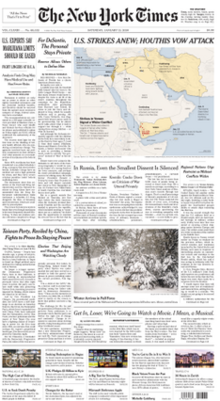Not known Facts About News Articles
Not known Facts About News Articles
Blog Article
8 Simple Techniques For News Articles
Table of ContentsThe Definitive Guide to News ArticlesGet This Report about News ArticlesMore About News Articles6 Simple Techniques For News ArticlesThe Best Strategy To Use For News Articles
Great understanding of different subjects offers trainees an affordable edge over their peers. Although digital and social networks are readily obtainable, we must not fail to remember how vital it is to review the papers. Moms and dads must attempt and instill the routine of reviewing a paper as a daily regimen to continue the legacy of the adored print medium.Information tales likewise have a minimum of one of the following important qualities about the intended target market: proximity, importance, timeliness, human rate of interest, curiosity, or repercussion. The associated term journalese is in some cases used, normally pejoratively, to refer to news-style writing. Another is headlinese. Newspapers typically stick to an expository writing style.
Within these limits, information stories likewise aim to be extensive. Amongst the bigger and extra highly regarded papers, justness and equilibrium is a significant factor in providing info.
Papers with a worldwide audience, for instance, often tend to make use of a more formal style of writing. News Articles.; typical design guides include the and the US Information Design Publication.
3 Easy Facts About News Articles Shown
As a rule, reporters will certainly not use a long word when a short one will certainly do. They use subject-verb-object building and construction and vivid, active prose (see Grammar). They provide narratives, instances and metaphors, and they seldom depend on generalizations or abstract ideas. News writers try to prevent making use of the same word extra than as soon as in a paragraph (often called an "resemble" or "word mirror").
Nonetheless, headings often leave out the subject (e.g., "Leaps From Boat, Catches in Wheel") or verb (e.g., "Cat woman fortunate"). A subhead (also subhed, sub-headline, subheading, subtitle, deck or dek) can be either a subservient title under the primary headline, or the heading of a subsection of the write-up. It is a heading that comes before the main message, or a team of paragraphs of the primary message.

Additional billboards of any of these kinds may show up later in the short article (particularly on succeeding pages) to entice more analysis. Such billboards are additionally used as pointers to the short article in other sections of the magazine or website, or as promotions for the item in various other magazine or sites. Regular structure with title, lead paragraph (summary in bold), various other paragraphs (details) and contact information.

Example look at this now of a hard-lead paragraph NASA is suggesting an additional area task. The company's budget request, introduced today, included a strategy to send another objective to the Moon. This moment the company really hopes to establish a long-term center as a jumping-off point for other room journeys. The budget plan requests roughly $10 billion for the task.
The NASA statement came as the firm asked for $10 billion of appropriations for the job. An "off-lead" is the second most vital front web page information of the day. The off-lead shows up either in the leading left edge, or straight below the lead on the. To "hide the lead" is to start the write-up with background information or information of second importance to the see this here visitors, compeling them to read more deeply right into a write-up than they must have to in order to uncover the important factors.
News Articles for Beginners
Common use is that or more sentences each create their own paragraph. Reporters typically describe the company or framework of a news tale as an upside down pyramid. The essential and most fascinating components of a story are put at the beginning, with sustaining information complying with in order of lessening relevance.
It allows individuals to check out a subject to only the deepness that their curiosity takes them, and without the imposition of information or subtleties that they might consider irrelevant, however still making that information offered to more interested readers. The upside down pyramid framework likewise allows posts to be cut to any type of approximate length during format, to suit the space available.
Some writers begin their tales with the "1-2-3 lead", yet there are lots of sort of lead readily available. This layout invariably begins with a "Five Ws" opening paragraph (as defined above), complied with by an indirect quote that offers to sustain a major element of the first paragraph, and after that a straight quote to sustain the indirect quote. [] A kicker can refer to several points: The last story in the news broadcast; a "satisfied" story to finish the program.
Longer articles, such as publication cover short articles and the items that lead the within areas of a newspaper, are known as. Feature stories vary from straight news in several methods.
News Articles - Truths
A function's very first paragraphs frequently relate a fascinating minute or occasion, as in an "unscientific lead". From the details of an individual or episode, its sight rapidly widens to generalities regarding the story's subject.

The Editor's Tool kit: A Reference Guide for Beginners and Professionals (2001) Allan M. you can try this out Siegal and William G. Connolly. The New York Times Guidebook of Style and Use: The Authorities Style Overview Utilized by the Writers and Editors of the World's The majority of Authoritative Paper (2002) M. L. Stein, Susan Paterno, and R.
Report this page